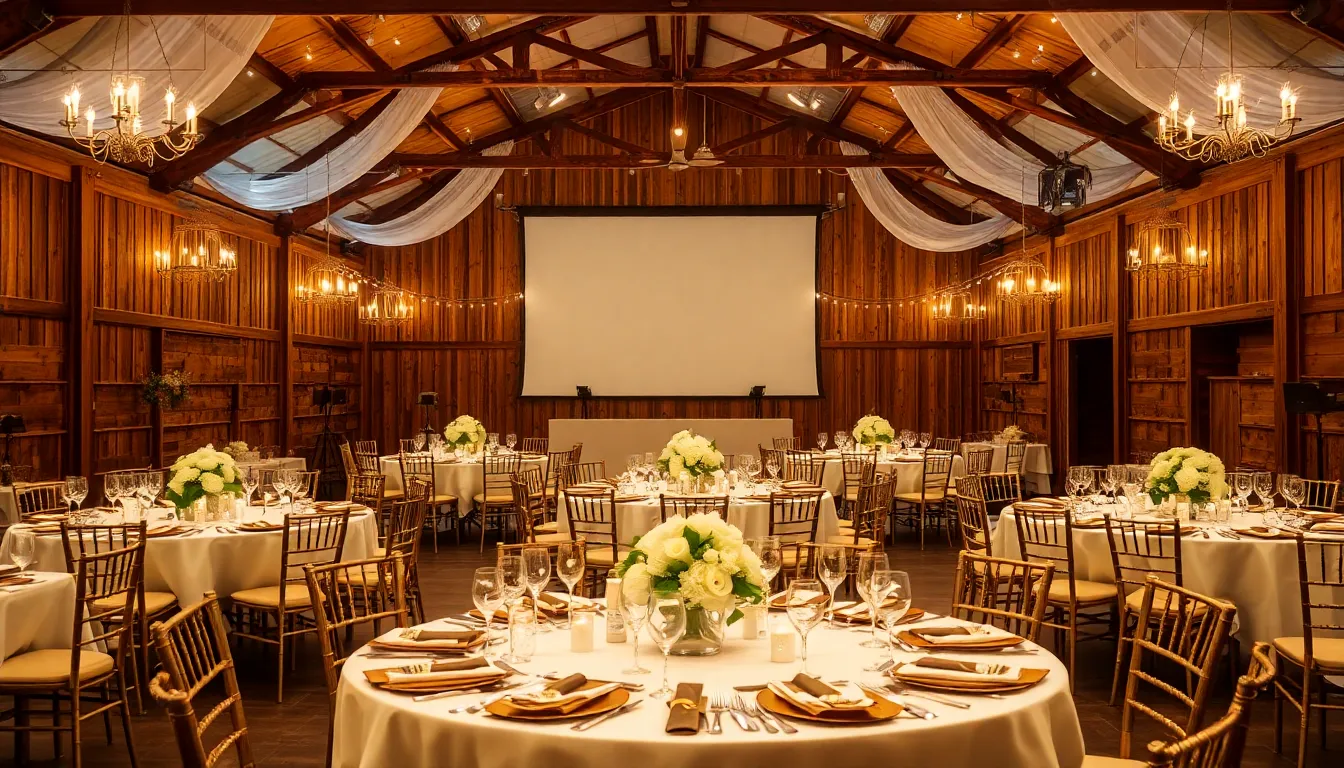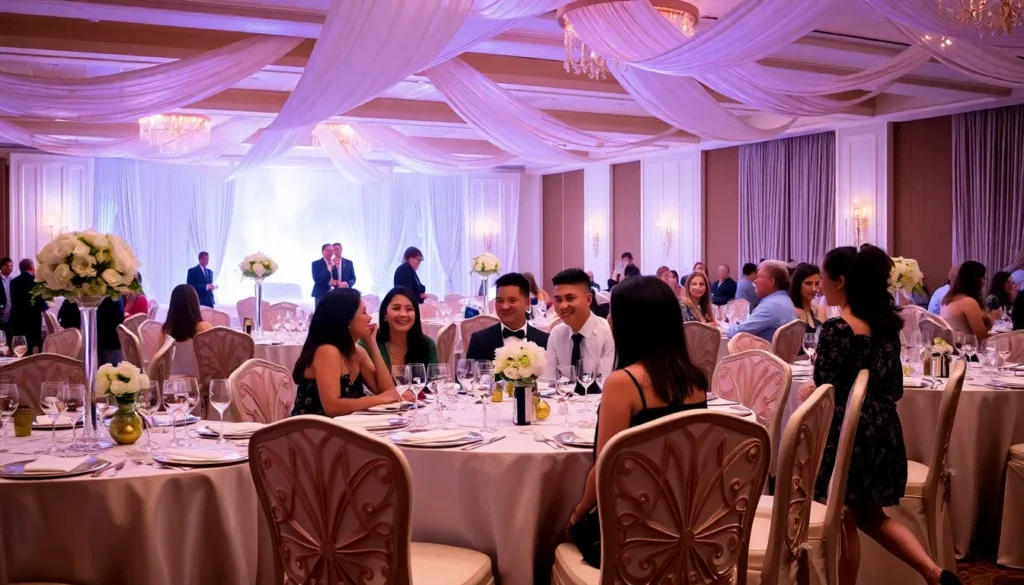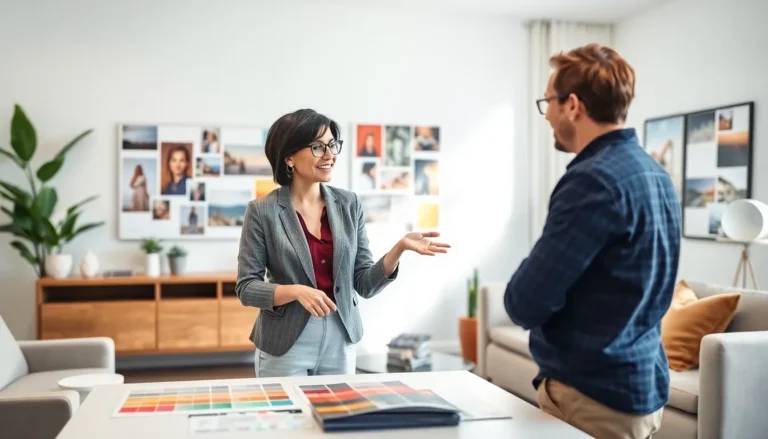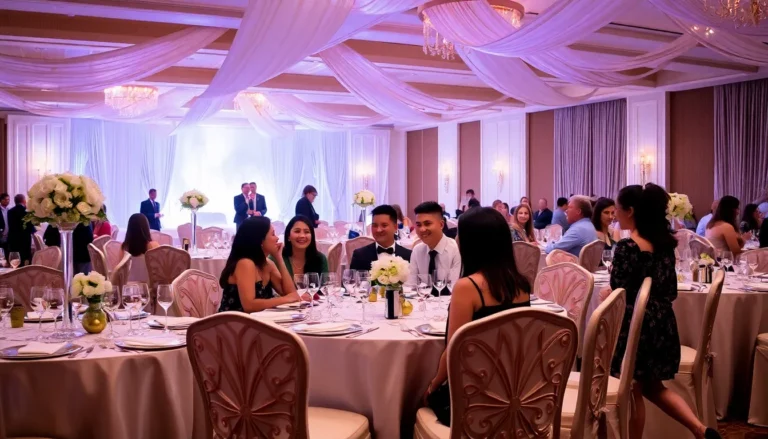When it comes to event decor design, first impressions matter more than that awkward moment when someone forgets your name at a party. Whether it’s a wedding, corporate gathering, or a birthday bash, the right decor can transform a plain space into a magical wonderland. Imagine guests walking in, jaws dropping, and their Instagram feeds lighting up with envy-inducing photos.
Table of Contents
ToggleThe Importance of Event Decor Design
Event decor design plays a crucial role in establishing the atmosphere at various gatherings. Memorable first impressions hinge on visually appealing decorations. Guests remember how decor transformed spaces, creating stunning environments that enhance their experiences.
Elevating a simple venue can increase engagement and enjoyment among attendees. Thoughtfully chosen decor elements evoke emotions, making events feel more personalized and special. Colors, textures, and fabrics impact the overall aesthetic, drawing in visitors and sparking conversations.
Social media buzz often stems from attractive decor. Guests eager to share their experiences capture photos amid beautifully arranged settings. A creative theme can become a focal point, encouraging sharing on platforms like Instagram and Facebook.
Coordinating decor with the event’s purpose is essential. Corporate events benefit from professional aesthetics that reflect brand values. Weddings thrive on romantic elements, showcasing personal stories through carefully selected design pieces.
Attention to detail influences how guests perceive the event. Small touches like table settings, flower arrangements, and lighting contribute to the overall atmosphere. Effective use of space combines strategic decor placement with functional design.
Event decor design isn’t just about visuals; it shapes experiences. It enhances guest interaction and engagement, making each occasion memorable. Well-executed decor aligns with the event’s goals while creating lasting impressions.
Elements of Effective Event Decor Design

Effective event decor design enhances the atmosphere and leaves a lasting impression on guests. Key elements such as color schemes, theme consistency, and lighting techniques play a significant role in achieving this.
Color Schemes
Choosing the right color scheme creates a mood that aligns with the event’s purpose. Colors convey emotions and set the tone; for instance, warm tones create intimacy while cool tones promote tranquility. Coordination among colors ensures visual harmony. Accent colors, when used thoughtfully, can highlight specific areas or elements like centerpieces and backdrops. Classic palettes such as gold and white exude elegance, while bold combinations can energize a corporate event. Guests often connect more deeply when colors correspond with the event’s theme.
Theme Consistency
Establishing theme consistency contributes to a cohesive event experience. The theme should resonate throughout decor elements, from invitations to table settings. All components, including floral arrangements and signage, need to reflect the chosen concept. For a rustic wedding, using natural materials like wood and burlap is essential. Events focused on modern aesthetics often incorporate geometric shapes and sleek finishes. Inconsistent themes can confuse guests, undermining the overall experience. Coordinating colors and styles reinforces the event’s narrative, enhancing guest engagement.
Lighting Techniques
Utilizing effective lighting techniques transforms an event space dramatically. Task lighting focuses on specific areas, while ambient lighting sets the overall mood. String lights create a whimsical atmosphere, perfect for outdoor settings. Spotlights can draw attention to key areas or decor elements like a cake table or a performance stage. Mood lighting, through dimming or colored gels, can adjust energy levels as the event progresses. A well-lit space enhances the decor and invites guests to explore. Lighting significantly shapes perceptions and experiences, making it a vital aspect of decor design.
Popular Trends in Event Decor Design
Trends in event decor design continually evolve, reflecting shifts in aesthetics and values. Current styles emphasize minimalism, luxury, and sustainability, shaping memorable experiences.
Minimalist Approaches
Simplicity defines minimalist approaches. Fewer decorations create a clean and uncluttered space, allowing key elements to shine. Neutral color palettes and simple lines enhance elegance without overwhelming guests. Natural materials like wood and stone add warmth and sophistication. Additionally, strategic placement of decor elements creates focal points, inviting attention without distraction.
Luxurious Touches
Sophisticated events often incorporate luxurious touches. Rich textures and opulent fabrics elevate the atmosphere, making guests feel pampered. Metallic accents and crystal embellishments provide a sense of glamour that captures attention and admiration. Bold color choices enrich the visual experience and create striking contrasts. Particularly effective in formal settings, these luxurious elements underpin a sense of grandeur, enhancing the overall perception of the event.
Sustainable Practices
Sustainable practices gain traction in event decor design. Eco-friendly materials and reusable decorations reduce environmental impact while still creating stunning visuals. Biodegradable elements, like natural centerpieces, resonate with values of responsibility and care. Many decorators focus on local sourcing to minimize carbon footprints. Additionally, integrating plants into designs not only beautifies spaces but also promotes sustainability, creating a positive association with memorable gatherings.
Tips for Successful Event Decor Design
Successful event decor design requires careful planning and execution. Implementing effective strategies significantly enhances the visual appeal of any gathering.
Budget Considerations
Budget determines what can be achieved in event decor design. Set a clear budget before making any purchases. Prioritize essential elements like centerpieces and lighting. Allocate funds to key items, ensuring that high-impact visuals receive proper investment. Remember that creative sourcing can yield impressive results. Opting for DIY decorations can also cut costs without sacrificing quality. Maintain a balance between elegance and affordability. Assess potential savings through careful selection of materials and rentals.
Collaborating with Professionals
Collaborating with professionals can enhance event decor outcomes. Hiring an experienced decorator can provide valuable insights and creative ideas. Establish clear communication about your vision and requirements. Shared goals ensure everyone is aligned on the decor theme. Provide feedback during the design process to refine elements effectively. Trusting a professional’s expertise allows for innovative solutions and designs. Involving experts also helps streamline the execution stage, ensuring timely setup and adjustments. Investing in professional assistance often translates into a polished, memorable experience for guests.
Event decor design plays a pivotal role in shaping unforgettable experiences. By thoughtfully selecting elements that resonate with the event’s purpose and audience, hosts can create environments that not only captivate but also engage guests. The integration of current trends like minimalism and sustainability reflects a commitment to both aesthetics and responsibility.
Effective planning and collaboration with professionals can elevate decor outcomes, ensuring all details align with the desired vision. As trends continue to evolve, staying informed and adaptable will keep event decor fresh and exciting. Ultimately, investing in quality decor transforms gatherings into cherished memories that guests will talk about long after the event has ended.



